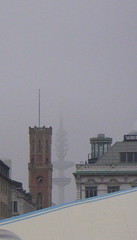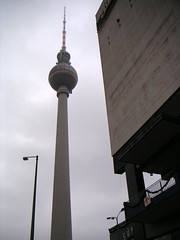I’m in the middle of a two-week intensive boot camp for trial lawyers, which explains my relative silence. Still, I was in Germany recently for 11 days, so here are some notes:
I flew over on Air France on a Boeing 777 and transferred there to a little ERJ-145 that took me to Hannover. Transferring at CDG was a bit of an adventure; apparently they’re doing a lot of construction, so the plane landed and then taxied around for several hours (all this, of course, is in the pre-dawn darkness of northern Europe) until finally parking somewhere near Brussels. Once there, we all got off the plane and on to a bus, which drove around the airport five or six times before finally getting to the terminal and letting us off. And then, of course, I had to hike several miles to get to my gate. I should say, however, that CDG’s Terminal 2F is a spectacular piece of brutalist architecture. If you’re going through Paris anytime, I think that it’s worth getting to the airport an extra half-hour early just to check it out.
Hannover is a lovely city, if a bit small. It was basically completely destroyed during WWII (a lot of historical plaques around the city note that something bad happened in 1943) and subsequently rebuilt. The main highlights include the baroque garden and the Neue Rathaus, a magnificent neo-baroque structure. Hannover will also be quick to remind you that the city was an independent kingdom and that the House of Hanover ruled England for a time. Basically, though, most of the highlights can be covered in two days (if you’re a slow walker and stop often for tea or coffee).
One thing about German cuisine is that it’s entirely dominated by Schweinfleisch (not that hard to figure out what that is). A popular dish is schweinhaxe (aka pork shank), which is a huge hunk of bone-in pork. The same cut, prepared somewhat differently, is called eisbein. After you eat one of those, you can’t but help wonder what happened to the rest of the pig. As for vegetables, just remember that sauerkraut isn’t just a vegetable, but it’s the vegetable. I ate more sauerkraut in eleven days than I’d ever eaten before in my life.
Also, German cities are famous for their Christmas Markets; however, I’d say that at least 2/3s of the stalls at these markets don’t sell gifts but rather mulled wine and various food items (i.e. sausage, sausage, and more sausage).
Hamburg is a surprisingly beautiful city. Full of canals, it allegedly has more than 4,000 bridges (though the question is does that count include footbridges). I didn’t take any pictures of any of those bridges, mainly because it was too dark. All the canals and little footbridges make it a seem like a German version of Venice. Plus, the Rathaus in Hamburg is sensational. Two comments: 1. If you listen to the tourist propaganda, it’s almost like Bismark never unified Germany; the city is almost always referred to as “the free and Hanseatic city of Hamburg” (despite the Hanseatic League having been entirely irrelevant for at least three hundred years); 2. the citizens of the city are, in fact, referred to as “Hamburgers.”One thing you will learn if you visit the little village of Hameln is that not only is the city perfectly happy to trade on the legend of the Pied Piper, but the legend is actually based on a real event. Unfortunately, no-one seems to know what actually happened on that fateful day in 1284, but whatever it was, it did leave a lasting impression. And, for the record, it seems that the rats were a 16th-century addition to the tale—originally, the story was just about a piper in brightly colored clothing who made 130 children disappear from the town. Creepy, huh?
Berlin is, of course, a fascinating city. First off, it’s huge. We were there for a full day and we barely scratched the surface. The Holocaust Memorial and the associated museum underneath it are stunning. The Checkpoint Charlie museum is fantastic, even if it does overreach itself at times. One curious thing about Berlin is that because of the Wall, it’s a city without a center. They’re starting to rebuild a center for the city, starting in Potsdamer Platz, but that’s so new that it doesn’t yet really feel organic (and this is some fifteen years after the fall of the wall).One thing I did notice is that the Germans are big on leaving monuments to the past. Most German cities (at least the few that I’ve been to) seem to have at least one bombed out church standing as a memorial to the war. Also, the Wall is still standing in a few stretches; the impulse seems to be to leave concrete reminders of the past so that it will never be repeated.
That’s it for now; if I find the time, I’ll write more later.



More creepy for me and my family - we are related to him. The Henrich Spanuth mentioned in your link, is a direct descendent and also a relative on my mothers' side.
We don't baby-sit, in honor of our heritage.